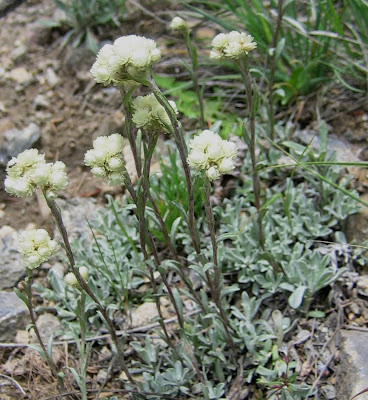There's an old joke that Butte America is just 15 minutes from Montana. Environmental recovery has come along well in the old mining town, but there's still some truth in the statement. At our home in Walkerville, the poppies are lighting up the front yard:
And on the hill behind, the Bitterroots (Lewisia rediviva; aka "rock roses") are blooming:
With the clear skies, it was time to head over the Continental Divide for a few days camping in the Big Hole River valley. I drove up a little creek where the Chokecherry (Prunus virginiana) blooms, scenting the air heavy & sweet:
And then up along a two-track until I came to a spring with a nice view of West Goat Peak--a good campsite:
I set up the spotting scope outside my tent so I could watch this mother antelope with her two fawns (one is nursing):
And a herd of elk cows and calves:
Dave Carter joined me for a wildflower hike. The high prairie is blooming--we saw Blue Camas (Camassia quamash), its root a staple food for the Indians that frequented this area over the past 10,000 years or so:
Silky Lupine (Lupinus sericeus)--both blue and the occasional white variant:
Parry's Lousewort (Pedicularis parryi purpurea; such an awful name for such a beautiful flower!):
Prairie Smoke (Geum triflorum):
Yellowish Paintbrush (Castilleja lutescens):
One of the many species of Biscuitroot (Lomatium spp):
And Little-flowered Penstemon (Penstemon procerus):
We also hiked over to Indian Rock, an overlook and prominent outcrop where indigenous peoples camped and hunted:
The old tipi rings are littered with tool flakes from the jasper that outcrops further up the valley, both yellow:
And red:
It's still a good hunting area, as the coyotes or wolves that killed this mule deer will attest:
Even antelope can be stalked closely at times when they think they are invisible in the sagebrush:
Dave left and MollyTheDog & I enjoyed the evening skies, including a passing shower that graced us with a rainbow:
Next morning, I caught a mess of brook trout for breakfast:
While two buck antelope played tag on a nearby hill:
The sandhill cranes strutted and hooted:
And a Wilson's snipe (western cousin of the woodcock) watched from a fencepost:
All too soon, it was time to pack up for home. Let's go, Molly:
Yep: Butte really is just 15 minutes from Montana.





















































